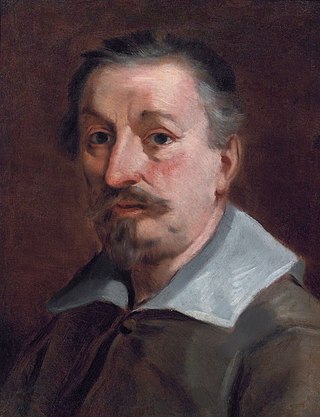
Francesco Albani or Albano was an Italian Baroque painter who was active in Bologna (1591–1600), Rome (1600–1609), Bologna (1609), Viterbo (1609–1610), Bologna (1610), Rome (1610–1617), Bologna (1618–1660), Mantova (1621–1622), Roma (1623–1625) and Florence (1633).

Girolamo Rainaldi was an Italian architect who worked mainly in a conservative Mannerist style, often with collaborating architects. He was a successful competitor of Bernini. His son, Carlo Rainaldi, became an even more notable, more fully Baroque architect.
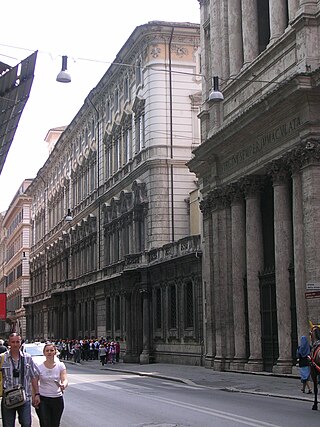
The Doria Pamphilj Gallery is a large private art collection housed in the Palazzo Doria Pamphilj in Rome, Italy, between Via del Corso and Via della Gatta. The principal entrance is on the Via del Corso. The palace façade on Via del Corso is adjacent to a church, Santa Maria in Via Lata. Like the palace, it is still privately owned by the princely Roman family Doria Pamphili. Tours of the state rooms often culminate in concerts of Baroque and Renaissance music, paying tribute to the setting and the masterpieces it contains.

Giovanni Battista Gaulli, also known as Baciccio or Baciccia, was an Italian artist working in the High Baroque and early Rococo periods. He is best known for his grand illusionistic vault frescos in the Church of the Gesù in Rome, Italy. His work was influenced by Gian Lorenzo Bernini.

The Accademia di San Luca is an Italian academy of artists in Rome. The establishment of the Accademia de i Pittori e Scultori di Roma was approved by papal brief in 1577, and in 1593 Federico Zuccari became its first principe or director; the statutes were ratified in 1607. Other founders included Girolamo Muziano and Pietro Olivieri. The Academy was named for Luke the Evangelist, the patron saint of painters.

The House of Chigi is an Italian princely family of Sienese origin descended from the counts of Ardenghesca, which possessed castles in the Maremma, southern Tuscany. Later, the family settled in Rome. The earliest authentic mention of them is in the 13th century, with one Alemanno, counsellor of the Republic of Siena.
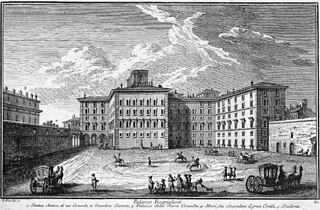
The Palazzo Pallavicini-Rospigliosi is a palace in Rome, Italy. It was built by the Borghese family on the Quirinal Hill; its footprint occupies the site where the ruins of the baths of Constantine stood, whose remains still are part of the basement of the main building, the Casino dell'Aurora. Its first inhabitant was the famed art collector Cardinal Scipione Borghese, the nephew of Pope Paul V, who wanted to be housed near the large papal Palazzo Quirinale. The palace and garden of the Pallavicini-Rospigliosi were the product of the accumulated sites and were designed by Giovanni Vasanzio and Carlo Maderno in 1611–16. Scipione owned this site for less than a decade, 1610–16, and commissioned the construction and decoration of the casino and pergolata, facing the garden of Montecavallo. The Roman palace of this name should not be mistaken for the panoramic Villa Pallavicino on the shores of Lake Como in Lombardy. The Palace has also been the scene of important cultural and religious events. On June 6, 1977 Princess Elvina Pallavicini invited in Palazzo Pallavicini Rospigliosi the archbishop monsignor Marcel Lefebvre for a conference on the Second Vatican Council and for the celebration of a Traditiona Mass, under the careful direction of the marquis Roberto Malvezzi, and Frigate Captain marquis Luigi Coda Nunziante di San Ferdinando. Many members of Alleanza Cattolica, the baron Roberto de Mattei, the pharmacologist Giulio Soldani, the sociologist Massimo Introvigne, the psychiatrist Mario Di Fiorino and Attilio Tamburrini and his brother Renato Tamburrini took part to the event.

Palazzo dei Diamanti is a Renaissance palace located on Corso Ercole I d'Este 21 in Ferrara, region of Emilia Romagna, Italy. The main floor of the Palace houses the Pinacoteca Nazionale di Ferrara.

Palazzo Borghese is a palace in Rome, Italy, the main seat of the Borghese family. It was nicknamed il Cembalo due to its unusual trapezoidal groundplan; its narrowest facade faces the River Tiber. The entrance at the opposite end of the building, the "keyboard" of the cembalo, faces onto the Fontanella di Borghese, with another in a great flanking facade to the Piazza Borghese that is extended by a slightly angled facade leading down Via Borghese towards the river. Both these entrances lead into a large courtyard on one side of which is a two level open arcade, with paired Doric and Ionic columns, that frames the garden beyond.
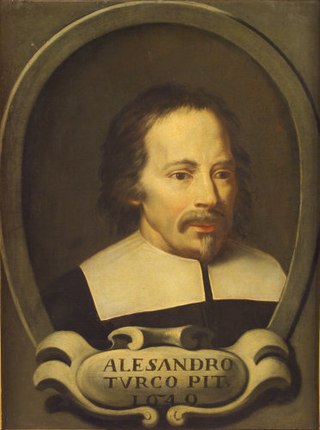
Alessandro Turchi was an Italian painter of the early Baroque, born and active mainly in Verona, and moving late in life to Rome. He also went by the name Alessandro Veronese or the nickname L'Orbetto. His style has been described as soft and Caravaggesque at the same time.

Giuseppe Nicola Nasini was an Italian painter of the Baroque period, active in Rome and Tuscany.

The Chigi Palace is a palace and former noble residence in Rome which is the seat of the Council of Ministers and the official residence of the Prime Minister of Italy. Since 22 October 2022, the tenant of the Chigi Palace has been Prime Minister Giorgia Meloni. It is located in the Piazza Colonna, next to Palazzo Montecitorio, seat of the Chamber of Deputies.

Giovanni Maria delle Piane was an aristocratic Genovese who served as primary court painter for over 60 years in the late-Baroque period. He is also known as "il Molinaretto".

Olimpia Aldobrandini was a member of the Aldobrandini family of Rome, and the sole heiress to the family fortune.
Paolo Borghese (1622/24–1646) was an Italian nobleman of the Borghese family. He was the son of Marcantonio II Borghese (1598–1658) and his wife Camilla Orsini.

Jacob Ferdinand Voet or Jakob Ferdinand Voet was a Flemish portrait painter. He had an international career that brought him to Italy and France, where he made portraits for an elite clientele. Voet is regarded as one of the best and most fashionable portrait painters of the High Baroque.
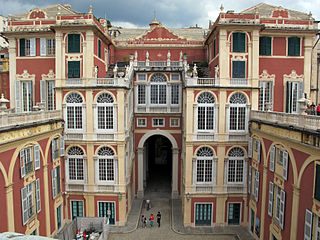
The Palazzo Reale or Palazzo Stefano Balbi is a major palace in Genoa.
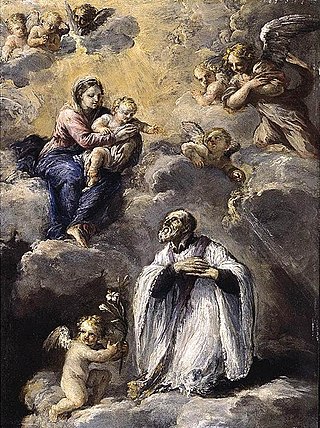
Ludovico Stern was an Italian painter of the Rococo or late-Baroque period, active in Rome. He is known for both large sacred and history paintings, as well as still lives, and portraits.
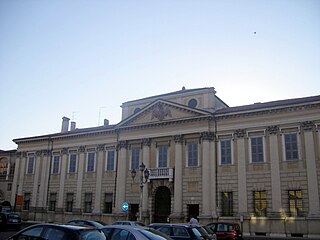
The Palazzo D'Arco is a Neoclassical-style palace located on Piazza Carlo D'Arco #4 in Mantua, region of Lombardy, Italy. The palace houses the Museo di Palazzo d'Arco, which displays the furnishings and artwork collected by the Duke D'Arco.


















